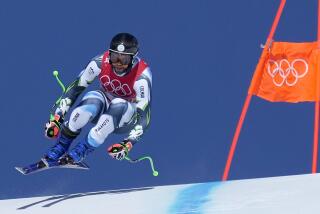Billy Kidd Manages to Keep Feet in Skiing
- Share via
NEW YORK — William Winston Kidd. Billy Kidd. Billy The Kid.
Silver medalist in the 1964 Winter Olympics, gold medalist in the 1970 World Championships, Kidd was an elite ski racer in a hell-bent-for-leather era.
“It was such a rush to ski that fast, knowing the course is smooth and that no people are in the way. You have no idea what it feels like to face a row of trees at 70 m.p.h. You’re pushing to the limits of speed and adhesion, and then you’re pushing for more speed.
“You can’t do that now. Ski areas have radar guns to slow you down.
“I read an article by Jackie Stewart that made a big impression on me. You know, car racing and ski racing--especially downhill racing--are very similar. That adrenaline rush, the concentration you get, is like you find in few other sports.
“It’s tough to retire with all the good things that go with sports, but then you throw in the adrenaline rush for somebody like a car racer or a downhill racer, where the adrenaline comes from the external danger factor, and that’s tough to replace.”
Kidd faced such a problem when he retired after the 1970 season. He, like all racers, wanted to stay in skiing. But he had to find a satisfying alternative to those headlong rushes down a snow-covered mountain.
He found it, at last, by becoming a teacher. He also works as a television commentator, keeps his hand in on equipment design, and has written an instructional book. But face-to-face teaching is his staple.
He opened a racing camp at Steamboat Springs, Colo. Everyone has seen the ads--Billy Kidd, wearing his trademark cowboy hat, charging down a mountain, grin a mile wide on his face. This is fun, the picture says, and for years people have come to Steamboat to share it with him.
“My interest now is mainly in recreational skiing, bringing new people into the sport. When I retired, if I had specialized in equipment design, it would maybe have been fun to apply the latest new technology to ski racing. But it’s much more interesting to watch people ski for the first time.
“I’m the ski coach for Special Olympics, and we’ve been going around to metropolitan areas, putting crushed ice down in the middle of town, inviting people to come out and try free instruction. They say, ‘I’ve always wanted to try skiing, but I thought it was too dangerous, or too expensive.’ Once they try it, they say, ‘It’s even more fun than I thought.’ Skiing is fun to watch and it’s even more fun to do.
“We were giving lessons in Chicago, and I noticed this little kid, about 7, standing off to one side. He had a sad face--no, it wasn’t a sad face, it’s just that he didn’t smile. I kept watching him while I was giving lessons, and he never smiled.
“So I went and got him, and all the while we’re getting him into boots and strapping him onto skis, he never smiled.
“Then we pushed off, down this 200-foot run, and the cameras started clicking, and the people started clapping--we were just barely moving--and suddenly there was this big smile across his face. Now he felt the movement, the wind in his face. Now he was a skier.
“For quite a while after that, while I was giving lessons to other people, I’d look over at him, and that smile was still there.
“That’s what makes it for me now. That’s what took the place of racing--the enjoyment of watching people come into the sport.”
More to Read
Go beyond the scoreboard
Get the latest on L.A.'s teams in the daily Sports Report newsletter.
You may occasionally receive promotional content from the Los Angeles Times.










